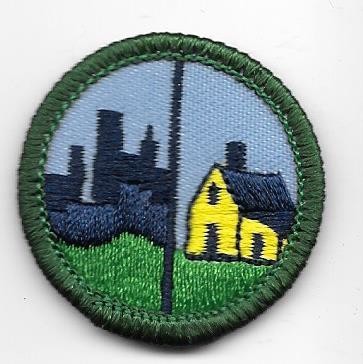Humans and Habitats Green Border 2001-2010
Complete any six of the following requirements to earn this badge:
1. Have Home, Will Travel In some countries, nomadic people (who move from place to place rather than live in one permanent spot) have invented homes that are very portable. Learn about the types of homes that nomadic people use today and used in the past.
2. It's Symbolic What are some of the symbols used to represent international organizations such as UNICEF, the Red Cross, the world health organization, and Girl Scouts? Invent a symbol or flag that could represent your community - its climate, geography, and way of life.
3. Farmers Around the World People almost everywhere grow food. Find out how people farm in 2 or 3 different countries. How does farming affect their environments? How are farming tools and other methods different from one country to the next?
4. Your Life Would Be Different If . . . Pick a place with a lifestyle that is different form your own - perhaps a rain forest, a desert, or Antarctica. Look around your home. What items would you have to live without? What items would you need instead?
5. Peace of Cake Since the 1960s, Peace Corps volunteers have lived in countries around the world working with communities on health, education, and other projects. Contact the local Peace Corps recruiting office or go to its web site and find out more about what Peace Corps workers do. Invite a returned Peace Corps volunteer to visit a troop or group meeting and share her experiences.
6. Make a Food Map Make a list of foods that you typically eat in one day. Research where these products are grown. Then make a products map that shows where the foods are grown. To make a product map, download a world map from the National Geographic Web site www.nationalgeographic.com/education . Draw or make symbols for each food, and make a key or legend for the map.
7. Break Bread People all around the world make and eat bread. Prepare one type and taste tow others from the list below. - Flat Bread (like tortilla, papadum, matzo) - Puffed Bread (like puri, beignet, donuts, sopapilla) - Filled Bread (like alu, paratha, pastelillo, gyoza) - Fried Bread (like pakora, fritters, pancakes, johnny cakes)
8. The World Close to Home Do you have many different kinds of restaurants in your town? Pick a certain type of food and find out how it is cooked in two cultures other than your own. Find out how the foods and the recipes reflect the climate and the geography of that country. For example, people in many hot climates cook very spicy dishes. Why? Spicy food makes you sweat, which makes your body cool off in the hot weather. Spicy food also hides the taste of unrefrigerated meat, which can spoil a little in hot weather.
9. Take a Look Around You Become a geography observer in your community. Do this alone or with others. Try to look at the following: - The kinds of crops and trees you see - How much land is empty and how much is used - What is on the land that is used, such as crops for farming, parks for recreation, open space to protect the environment, or building used for housing, business, government, shopping, and other uses. Would you keep the land the way it is, or would you make changes? Write a letter or send an email with your ideas to the zoning or planning board in your community, or attend a zoning board meeting.
10. What's Best? How do different living environments compare? Look at living in a apartment building, single-family home, farmhouse, mobile home, or modular home. How are things different in cities, suburbs, villages, and rural units? In your troop or with others, find a way to show your" dream environments" - your favorite types of homes in your favorite types of communities.
